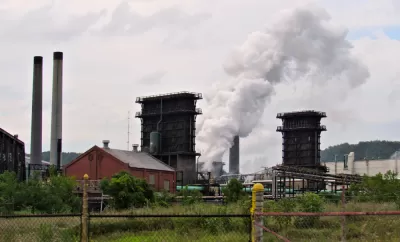The U.S. Environmental Protection Agency estimated its new rule change will result in up to 1,258 tons of additional emissions of hazardous materials every year.

"The Environmental Protection Agency (EPA) on Thursday finalized a rule that could reclassify many 'major' sources of pollution as minor ones, allowing facilities to abide by less-stringent emissions standards for dangerous substances such as mercury, lead and arsenic," report Rebecca Beitsch and Rachel Frazin.
"The rule allows major sources to become reclassified if they now meet the hazardous air pollutants guidelines in place for the smaller “area” polluters — producing 10 tons per year or less of a single toxin, or 25 tons a year for facilities that emit multiple toxins," explain Beitsch and Frazin in more detail.
The EPA estimates the rule change "will result in up to 1,258 tons per year of additional emissions of hazardous air pollutants," according to the article, and 3,900 polluters are now eligible for reclassification.
John Walke, a senior attorney with the Natural Resources Defense Council, is quoted in the article criticizing the rule change, saying it's a gratuitous example of "extreme ideology over public health, common sense and the law." The article also predicts that environmental groups are likely to challenge the rule change in court.
FULL STORY: EPA finalizes rule allowing some major polluters to follow weaker emissions standards

Planetizen Federal Action Tracker
A weekly monitor of how Trump’s orders and actions are impacting planners and planning in America.

Congressman Proposes Bill to Rename DC Metro “Trump Train”
The Make Autorail Great Again Act would withhold federal funding to the system until the Washington Metropolitan Area Transit Authority (WMATA), rebrands as the Washington Metropolitan Authority for Greater Access (WMAGA).

The Simple Legislative Tool Transforming Vacant Downtowns
In California, Michigan and Georgia, an easy win is bringing dollars — and delight — back to city centers.

The States Losing Rural Delivery Rooms at an Alarming Pace
In some states, as few as 9% of rural hospitals still deliver babies. As a result, rising pre-term births, no adequate pre-term care and "harrowing" close calls are a growing reality.

The Small South Asian Republic Going all in on EVs
Thanks to one simple policy change less than five years ago, 65% of new cars in this Himalayan country are now electric.

DC Backpedals on Bike Lane Protection, Swaps Barriers for Paint
Citing aesthetic concerns, the city is removing the concrete barriers and flexposts that once separated Arizona Avenue cyclists from motor vehicles.
Urban Design for Planners 1: Software Tools
This six-course series explores essential urban design concepts using open source software and equips planners with the tools they need to participate fully in the urban design process.
Planning for Universal Design
Learn the tools for implementing Universal Design in planning regulations.
Smith Gee Studio
City of Charlotte
City of Camden Redevelopment Agency
City of Astoria
Transportation Research & Education Center (TREC) at Portland State University
US High Speed Rail Association
City of Camden Redevelopment Agency
Municipality of Princeton (NJ)





























